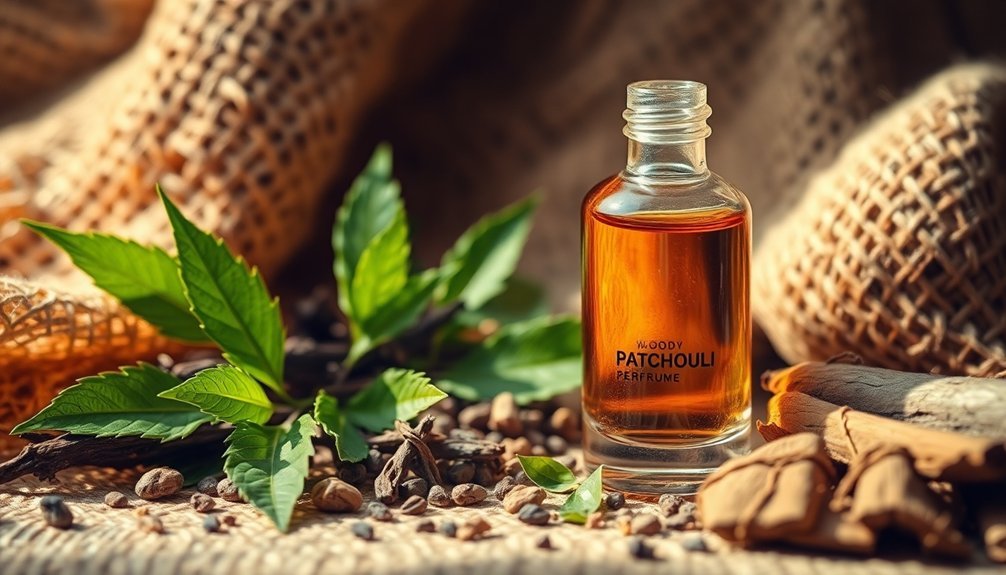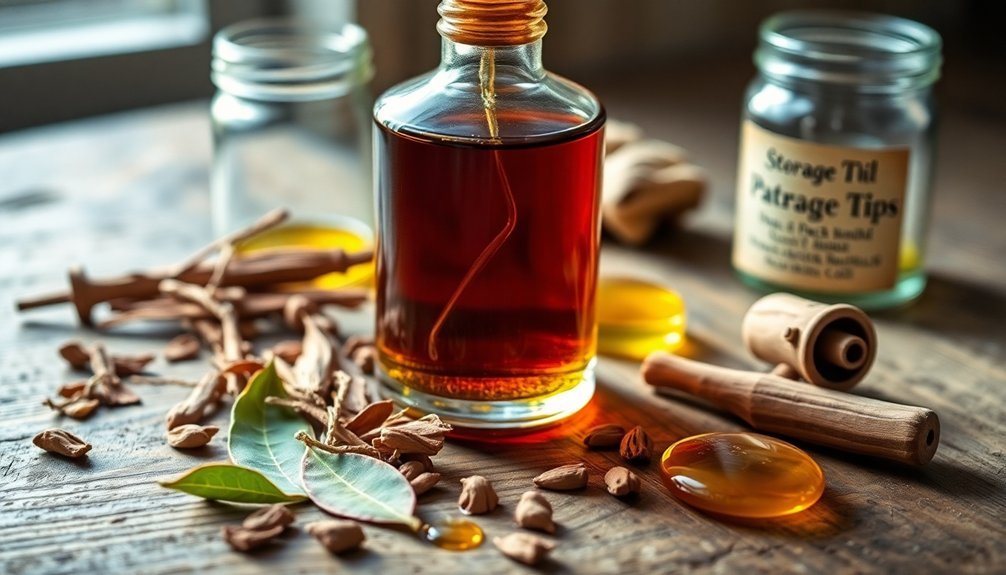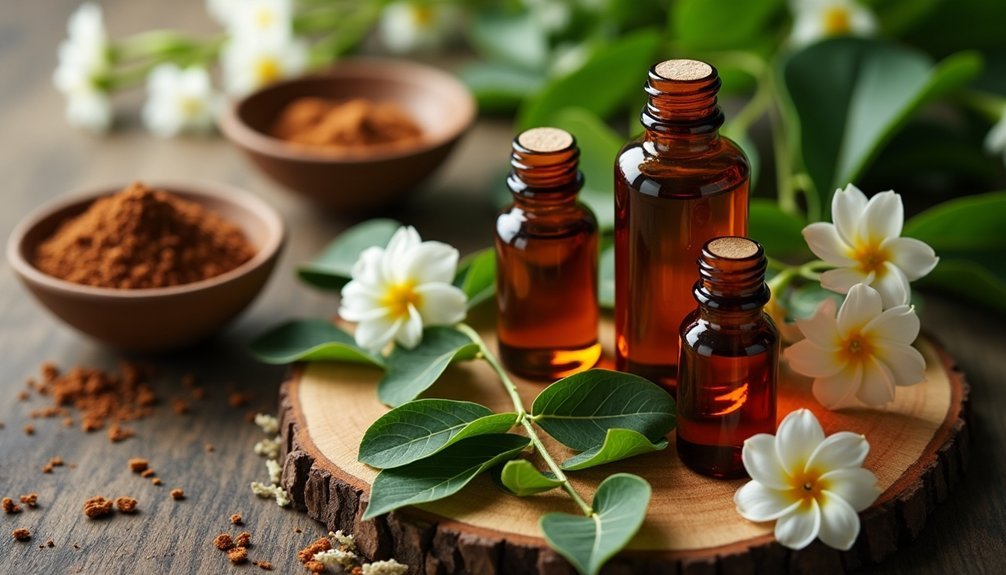To create a rich woody patchouli perfume, you'll need essential oils like patchouli, cedarwood, and sandalwood as your base notes, along with bergamot and vetiver for depth. Start by combining these oils in a dark glass bottle, adding carrier oils like grapeseed or almond for dilution. Mix your layers carefully, beginning with base notes before adding lighter scents. Proper storage in a cool, dark place will help your custom blend develop its complex, earthy character over time.
The Magic of Woody Patchouli Perfume

While many fragrances come and go, woody patchouli perfume has maintained its allure for generations.
You'll discover a unique blend of earthy, musky, and sensual notes that create an intoxicating bouquet unlike any other scent. Despite belonging to the mint family, patchouli's distinct aroma stands apart with its rich, enveloping character. The essential oil is especially valued for its ability to ease anxiety and stress.
What makes this fragrance truly magical is its versatility. You can wear it regardless of gender, and it blends beautifully with a wide range of notes – from delicate florals like rose and ylang-ylang to bold spices and citrus accents.
Whether you're seeking a luxurious signature scent or exploring aromatherapy benefits, patchouli delivers with its powerful yet sophisticated presence.
It's no wonder this timeless ingredient continues to captivate perfume enthusiasts worldwide.
Essential Ingredients and Tools You'll Need
Creating a high-quality woody patchouli perfume requires three essential categories of ingredients and a specific set of tools.
You'll need core essential oils including patchouli, cedarwood, sandalwood, bergamot, and vetiver to establish the signature woody base.
For proper dilution and blending, you'll want to choose either grapeseed or almond oil as your carrier. A graduated cylinder will ensure precise measurements when working with carrier oils.
To add depth and complexity, incorporate aromatic enhancers like tonka bean absolute, labdanum resinoid, and vanilla resinoid.
You can further customize your scent with floral and herbal notes using lavender, rose, palmarosa, neroli, or clary sage essential oils.
Don't forget the vital tools: a digital scale for precise measurements, borosilicate beakers, glass measuring cylinders, stainless steel funnels, and a thermometer for temperature control.
Step-by-Step Mixing Instructions

You'll begin creating your woody patchouli perfume by measuring out the base components, primarily focusing on patchouli and cedarwood in precise drop counts that total 20% of your final blend.
Next, you'll carefully combine your essential oils layer by layer, starting with the base notes, then adding the middle notes at 50% concentration, and finishing with the top notes at 30%.
To guarantee a well-balanced fragrance, you'll need to mix each layer thoroughly before moving on to the next, keeping detailed notes of your measurements for future reference. Always store your completed blend in a dark glass bottle to properly preserve the fragrance.
Measuring Base Components
Before diving into the intricate blend of essential oils, you'll need to measure your base components with precision and care.
Using a precise scale or dropper, measure out your carrier oil, which should make up 80-90% of your total mixture. For this woody patchouli blend, jojoba or fractionated coconut oil works particularly well.
Next, measure your base notes, which will constitute about 50% of your essential oil portion.
You'll want to focus on patchouli and cedarwood as your primary base notes, as they'll provide the deep, earthy foundation for your perfume.
Pour these into a glass bottle, making sure to document the exact measurements for future reference.
Remember to test the strength on a small patch of skin before proceeding with the rest of your blend.
Blending Essential Oil Layers
Now that your base components are measured, the artful process of layering essential oils begins. Start with your base note patchouli, adding it drop by drop to your mixing vessel. Let it settle for a moment before proceeding to your middle notes.
- Watch the rich amber drops swirl and dance as you blend them
- Observe how each layer mingles with the previous one
- Notice the scent evolving with every addition
Remember to take short breaks between adding layers to prevent nose fatigue.
Add your middle notes next, gently swirling the mixture after each addition.
Finally, incorporate your top notes, following the 3:2:1 ratio for a balanced blend.
Test the scent on a perfume strip, allowing it to develop for a few minutes before making any final adjustments to achieve your desired woody aroma.
Understanding Fragrance Notes and Blending
When creating your woody patchouli perfume, you'll notice how base notes like patchouli and cedarwood provide lasting depth while top notes like bergamot and lemon offer immediate freshness.
Understanding this contrast helps you build a well-structured fragrance that evolves beautifully on the skin.
The key is finding the right balance between your essential oils, allowing the woody base notes to anchor the composition while lighter notes create an inviting initial impression.
Base Vs Top Notes
Understanding the interplay between base and top notes is essential for creating a balanced woody patchouli perfume. Base notes, like patchouli and sandalwood, make up 5-10% of your blend and provide lasting depth for 6+ hours.
In contrast, top notes like citrus and herbs comprise 20-40% of the blend but evaporate within 30 minutes.
When blending, imagine:
- A sturdy foundation of earthy patchouli anchoring your fragrance
- Warm, woody cedarwood notes intertwining with the base
- Bright citrus sparks dancing briefly on top
You'll want to add your base notes drop by drop, allowing them to establish a solid foundation while ensuring they don't overpower the composition.
The top notes will provide that initial burst of freshness before settling into the deeper, lasting aroma.
Essential Oil Harmony
Creating a harmonious blend of essential oils requires mastering the delicate balance between fragrance notes. You'll want to combine patchouli's deep, earthy base notes with uplifting citrus top notes and floral middle notes for a well-rounded fragrance.
| Note Level | Essential Oils | Characteristics |
|---|---|---|
| Top Notes | Orange, Lemon | Fresh, uplifting |
| Middle Notes | Rose Geranium | Floral, balancing |
| Base Notes | Patchouli | Earthy, grounding |
| Support Notes | Cypress | Woody, fresh |
| Fixative Notes | Cedarwood | Deep, lasting |
When blending these oils, start with your base note of patchouli, then layer in your middle notes for complexity. Finally, add your top notes to create that initial burst of freshness. Remember that each oil contributes to both the fragrance and therapeutic benefits, working together to create emotional balance and sensory pleasure.
Application Methods and Storage Tips

To maximize the enjoyment and longevity of your woody patchouli perfume, proper application and storage techniques are essential.
Apply your fragrance to warm, moisturized skin, focusing on pulse points like your wrists, neck, and inside elbows.
Don't rub the perfume, as this can break down the fragrance molecules and alter the scent's integrity.
Store your woody patchouli creation properly to preserve its rich, earthy notes:
- Keep the bottle in a cool, dark closet away from direct sunlight and bathroom humidity
- Always seal the cap tightly and avoid excessive shaking of the bottle
- Use the original packaging to protect against light exposure and temperature fluctuations
For best results, apply your perfume after showering when your skin is clean and warm, and consider using a matching scented body lotion to enhance the fragrance's staying power.
The Science Behind Woody Scents
While proper application methods enhance your perfume's performance, the molecular structure of woody scents explains their remarkable staying power. You'll find that woody fragrances contain dense, less volatile molecules like sesquiterpenes and patchoulol, which evaporate more slowly than lighter scents.
The science behind woody fragrances is fascinating. When you blend patchouli, vetiver, or sandalwood into your perfume, their heavy molecular structure acts as an anchor for more volatile top notes.
These base notes don't just provide depth; they actually help fix other scents in place, extending the overall longevity of your fragrance.
What's even more interesting is that woody scents often improve with age, becoming richer and more complex over time due to their unique molecular composition.
Frequently Asked Questions
How Long Does Homemade Patchouli Perfume Typically Last on Skin?
Your homemade patchouli perfume can last 4-8 hours on moisturized skin, but you'll notice it's strongest in the first 2-3 hours. With proper skin prep and natural fixatives, you'll extend its longevity.
Can I Substitute Witch Hazel With Another Base Ingredient?
Yes, you can replace witch hazel with perfumer's alcohol or vodka for better preservation. You'll also get good results using jojoba oil or fractionated coconut oil as carrier bases, though they won't preserve as well.
Will the Fragrance Change if I Add More Glycerin?
No, adding more glycerin won't change your fragrance. While it'll make your perfume thicker and possibly sticky, glycerin is neutral and doesn't affect the scent notes. It's best to stick to recommended amounts.
Is This Perfume Recipe Safe for Sensitive Skin?
You'll need to do a patch test first since even natural ingredients can cause reactions. While it's designed to be gentle, if you have sensitive skin, consult a dermatologist before using any new fragrance.
Can I Mix Different Essential Oil Brands in This Recipe?
You can mix different essential oil brands, but guarantee they're all pure, high-quality oils. Test small batches first and stay consistent with reputable brands to maintain the blend's therapeutic properties and scent profile.
In Summary
Now you're ready to create your own woody patchouli perfume that'll turn heads and ground your senses. Whether you choose to wear it daily or save it for special occasions, you've learned the art of blending earthy notes into a signature scent. Keep experimenting with different ratios and complementary oils until you find your perfect balance. Store your creation properly, and it'll reward you with months of rich, aromatic pleasure.





Leave a Reply